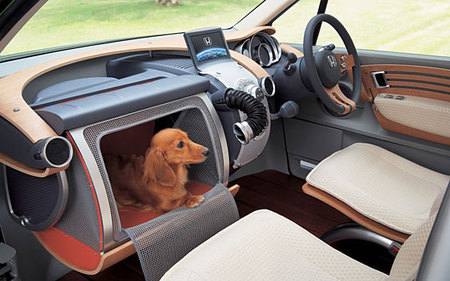
Travelling with your dog usually involves more than putting the them in a car and driving off, especially if you will be driving long distances or be away for a long time.
If your pet is not accustomed to the car, take it for a few short rides before the trip. This can help keep your pet from becoming nervous or agitated, and may lessen the effects of motion sickness. If, after a number of practice trips, your pet continues to cry excessively or becomes sick please contact Miranda or Jeff.
Buckling up is an important safety precaution for your pet. Restraints have several advantages. They help protect pets in case of a crash, and they keep pets from running loose and distracting the driver. They also keep pets from escaping the car through an open window or door. Cats and smaller dogs are often most comfortable in crates or carriers, which can be purchased in various sizes. Crates give many dogs a sense of security and familiar surroundings, and can be secured to the car seat with a seat belt or a specially designed carrier restraint. There are also dogs restraints available that can be used without carriers, including harnesses, seat belt attachments and vehicle barriers. No matter what kind of restraint you use, be sure that it does not permit your pet's head to extend outside the car window. If pets ride with their heads outside the car, particles of dirt can penetrate the eyes, ears, and nose, causing injury or infections. Excessive amounts of cold air taken into lungs can also cause illness.
While packing for your trip, remember to throw in a few of your pet's favourite toys, food and water bowls, a leash, and food. You should also carry a first aid kit for your pet and know basic pet first aid. If your pet is on medication, be sure to have plenty for the trip, and then some.
Stick to your regular feeding routine while travelling, and give your pet its main meal at the end of the day or when you've reached your destination. It will be more convenient to feed dry food if your pet is used to it. Dispose of unused canned food unless it can be refrigerated. Take along a plastic jug of cold water to avoid possible stomach upset the first day, as new areas can have minerals or bacteria in their water supply that pets need time to adjust to. Give your pet small portions of both food and water and plan to stop every two hours for exercise/loo trips.
Remember that your vet is a good source of information about what your pet will need when travelling. Consider having your pet examined before you leave as well, to check for any developing problems. Have your current vet's phone number handy in case of an emergency. Also, be sure to travel with a copy of your pet's medical records, especially if the animal has a difficult medical history.
Find hotels, bed and breakfasts, and campsites that accept animals and book them ahead of time. Learn more about the area you will be visiting. Your vet can tell you if there are any diseases like heartworm or Lyme disease and vaccinations or medications your pets may require. If travelling outside of the UK your pet may require a pet passport. A health examination following your trip should be considered to determine if any internal parasites (roundworms, hookworms, heartworms) or external parasites (ticks, fleas) were picked up in contaminated exercise or wooded areas.
To avoid losing your pet during a trip, make sure your pet is wearing an i.d. tag. To be doubly protected, consider having your pet tattooed or having a microchip implanted.



No comments:
Post a Comment